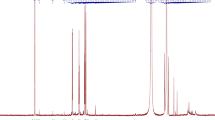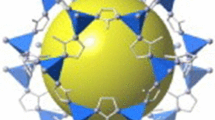Abstract
Covalent organic framework (COF) materials are one of porous sorbents with the capability to improve bioavailability and solubility of drugs, while also controlling the drug release for profound long-term implications in drug delivery systems. Here, using a facile self-assembly method, COF with high ability to modify the customary formulation of antibiotic drugs including trimethoprim (TMP) is synthesized. The resulting nanoporous COF characterized by different techniques such as field-emission scanning electron microscopy, Fourier-transform infrared spectroscopy, X-ray diffraction, BET/BJH, and zeta potential, can be prescribed as an antibiotic against most of bacteria. Antibacterial properties of the TMP encapsulated by COF (TMP@COF) is investigated, leading to significantly lower minimum inhibitory concentrations (1.25 and 2.5 μg/mL) compared to pure TMP (10 μg/mL), which can propose it as a highly efficient nanocarrier against both gram-negative and gram-positive bacteria. The release kinetics of TMP@COF is also studied using zero-order, first-order, Higuchi, and Korsmeyer-Peppas models. Our results indicate that the diffusion kinetics of the COF nanodrug carrier is consistent with the Higuchi model, thus evidencing the possibility of stable TMP diffusion from the porous material.
Graphical abstract










Similar content being viewed by others
Availability of data and material
The data will be available upon reasonable request.
Abbreviations
- TMP:
-
Trimethoprim
- DDS:
-
Drug delivery system
- COF:
-
Covalent organic framework
- MIC:
-
Minimum inhibitory concentration
References
Andersson DI, Balaban NQ, Baquero F, Courvalin P, Glaser P, Gophna U, Kishony R, Molin S, Tønjum T (2020) Antibiotic resistance: turning evolutionary principles into clinical reality. FEMS Microbiol Rev 44:171–188
Syed A (2019) Antibiotic use and resistance. Int J Curr Res Med Sci 5:17–23
Chen L, Liang J (2020) An overview of functional nanoparticles as novel emerging antiviral therapeutic agents. Mater Sci Eng C 112:110924
Mehrabi F, Mohamadi M, Mostafavi A, Hakimi H, Shamspur T (2020) Magnetic solid phase extraction based on PVA-TEOS/grafted Fe3O4@ SiO2 magnetic nanofibers for analysis of sulfamethoxazole and trimethoprim in water samples. J Solid State Chem 292:121716
Mokhtar HI, Abdel-Salam RA, Hadad GM (2019) Tolerance intervals modeling for design space of a salt assisted liquid-liquid microextraction of trimethoprim and six common sulfonamide antibiotics in environmental water samples. J Chromatogr A 1586:18–29
Saidin S, Jumat MA, Amin NAAM, Al Hammadi ASS (2020) Organic and inorganic antibacterial approaches in combating bacterial infection for biomedical application. Mater Sci Eng C 118:111382
Bae YH, Park K (2020) Advanced drug delivery 2020 and beyond: perspectives on the future. Adv Drug Deliv Rev 158:4–16
Mehrabi F, Shamspur T, Sheibani H, Mostafavi A, Mohamadi M, Hakimi H, Bahramabadi R, Salari E (2021) Silver-coated magnetic nanoparticles as an efficient delivery system for the antibiotics trimethoprim and sulfamethoxazole against E. Coli and S. aureus: release kinetics and antimicrobial activity. Biometals 34:1–10
Mehrabi F, Shamspur T, Mostafavi A, Saljooqi A, Fathirad F (2017) Synthesis of cellulose acetate nanofibers and its application in the release of some drugs. Nanomed Res J 2:199–207
Ye M, Han Y, Tang J, Piao Y, Liu X, Zhou Z, Gao J, Rao J, Shen Y (2017) A tumor-specific cascade amplification drug release nanoparticle for overcoming multidrug resistance in cancers. Adv Mater 29:1702342
Wang W, Jing T, Xia X, Tang L, Huang Z, Liu F, Wang Z, Ran H, Li M, Xia J (2019) Melanin-loaded biocompatible photosensitive nanoparticles for controlled drug release in combined photothermal-chemotherapy guided by photoacoustic/ultrasound dual-modality imaging. Biomater Sci 7:4060–4074
Gordillo-Galeano A, Mora-Huertas CE (2018) Solid lipid nanoparticles and nanostructured lipid carriers: a review emphasizing on particle structure and drug release. Eur J Pharm Biopharm 133:285–308
Aghebati-Maleki A, Dolati S, Ahmadi M, Baghbanzhadeh A, Asadi M, Fotouhi A, Yousefi M, Aghebati-Maleki L (2020) Nanoparticles and cancer therapy: Perspectives for application of nanoparticles in the treatment of cancers. J Cell Physiol 235:1962–1972
Guan Q, Zhou LL, Li WY, Li YA, Dong YB (2020) Frontispiece: covalent organic frameworks (COFs) for cancer therapeutics. Chem A Eur J 26:5583–5591
Zhao F, Liu H, Mathe SD, Dong A, Zhang J (2018) Covalent organic frameworks: from materials design to biomedical application. Nanomaterials 8:15
Sun T, Xia R, Zhou J, Zheng X, Liu S, Xie Z (2020) Protein-assisted synthesis of nanoscale covalent organic frameworks for phototherapy of cancer. Mater Chem Front 4:2346–2356
Zhang Y, Zhang L, Wang Z, Wang F, Kang L, Cao F, Dong K, Ren J, Qu X (2019) Renal-clearable ultrasmall covalent organic framework nanodots as photodynamic agents for effective cancer therapy. Biomaterials 223:119462
Jia Y, Zhang L, He B, Lin Y, Wang J, Li M (2020) 8-Hydroxyquinoline functionalized covalent organic framework as a pH sensitive carrier for drug delivery. Mater Sci Eng C 117:111243
Yang LL, Zhang L, Wan SC, Wang S, Wu ZZ, Yang QC, Xiao Y, Deng H, Sun ZJ (2021) Two-photon absorption induced cancer immunotherapy using covalent organic frameworks. Adv Func Mater 31:2103056
Wang J, Zhuang S (2019) Covalent organic frameworks (COFs) for environmental applications. Coord Chem Rev 400:213046
Oliveira ADS, Rivero-Buceta EM, Vidaurre-Agut C, Misturini A, Moreno V, Jordá JL, Sastre G, Pergher SBC, Botella P (2020) Sequential pore wall functionalization in covalent organic frameworks and application to stable camptothecin delivery systems. Mater Sci Eng C 117:111263
Salazar-Mendoza D, Guerrero-Alvarez J, Höpfl H (2008) 3-Pyridineboronic acid→ boroxine→ pentadecanuclear boron cage→ 3D molecular network: a sequence based on two levels of self-complementary self-assembly. Chem Commun 48:6543–6545
Mehrabi F, Shamspur T, Mostafavi A, Hakimi H, Mohamadi M (2021) Inclusion of sulfamethoxazole in a novel CuFe2O4 nanoparticles/mesoporous silica-based nanocomposite: release kinetics and antibacterial activity. Appl Organometall Chem 35:e6035
Biemer JJ (1973) Antimicrobial susceptibility testing by the Kirby-Bauer disc diffusion method. Ann Clin Lab Sci 3:135–140
Olson WP (2020) Separations technology: pharmaceutical and biotechnology applications. CRC Press, Boca Raton
Seo J-K, Lee MJ, Go H-J, Kim YJ, Park NG (2014) Antimicrobial function of the GAPDH-related antimicrobial peptide in the skin of skipjack tuna, Katsuwonus pelamis. Fish Shellfish Immunol 36:571–581
Akyuz L (2020) An imine based COF as a smart carrier for targeted drug delivery: From synthesis to computational studies. Microporous Mesoporous Mater 294:109850
Han Y, Zhang M, Zhang Y-Q, Zhang Z-H (2018) Copper immobilized at a covalent organic framework: an efficient and recyclable heterogeneous catalyst for the Chan-Lam coupling reaction of aryl boronic acids and amines. Green Chem 20:4891–4900
Afshari M, Dinari M (2020) Synthesis of new imine-linked covalent organic framework as high efficient absorbent and monitoring the removal of direct fast scarlet 4BS textile dye based on mobile phone colorimetric platform. J Hazardous Mater 385:121514
Bekçi Z, Seki Y, Yurdakoç MK (2007) A study of equilibrium and FTIR, SEM/EDS analysis of trimethoprim adsorption onto K10. J Mol Struct 827:67–74
Du Y, Mao K, Kamakoti P, Ravikovitch P, Paur C, Cundy S, Li Q, Calabro D (2012) Experimental and computational studies of pyridine-assisted post-synthesis modified air stable covalent–organic frameworks. Chem Commun 48:4606–4608
Hayati-Ashtiani M (2011) Characterization of nano-porous bentonite (montmorillonite) particles using FTIR and BET-BJH analyses. Part Part Syst Charact 28:71–76
Heydari A, Mehrabi F, Shamspur T, Sheibani H, Mostafavi A (2018) Encapsulation and controlled release of vitamin B 2 using Peracetyl-β-Cyclodextrin polymer-based electrospun nanofiber scaffold. Pharm Chem J 52:19–25
Ali M, Horikawa S, Venkatesh S, Saha J, Hong JW, Byrne ME (2007) Zero-order therapeutic release from imprinted hydrogel contact lenses within in vitro physiological ocular tear flow. J Control Release 124:154–162
Kariminia S, Shamsipur A, Shamsipur M (2016) Analytical characteristics and application of novel chitosan coated magnetic nanoparticles as an efficient drug delivery system for ciprofloxacin. Enhanced drug release kinetics by low-frequency ultrasounds. J Pharm Biomed Anal 129:450–457
Huang J, Wigent RJ, Bentzley CM, Schwartz JB (2006) Nifedipine solid dispersion in microparticles of ammonio methacrylate copolymer and ethylcellulose binary blend for controlled drug delivery: effect of drug loading on release kinetics. Int J Pharm 319:44–54
Lee PI (1984) Effect of non-uniform initial drug concentration distribution on the kinetics of drug release from glassy hydrogel matrices. Polymer 25:973–978
Funding
This study was supported by grants from the University of Kashan and the Graduate University of Advanced Technology of Kerman.
Author information
Authors and Affiliations
Corresponding author
Ethics declarations
Conflict of interest
The authors declare that they have no conflict of interest.
Code availability
Not applicable.
Consent for publication
By submitting the manuscript, the authors understand that the material presented in this manuscript has not been published before, nor has it been submitted for publication to another journal. The corresponding author attests that this study has been approved by all the co-authors concerned.
Additional information
Publisher's Note
Springer Nature remains neutral with regard to jurisdictional claims in published maps and institutional affiliations.
Rights and permissions
About this article
Cite this article
Salehi, A., Behpour, M. & Afzali, D. Investigation into the antibacterial activity of covalent organic frameworks as a delivery system of trimethoprim against Escherichia coli and Staphylococcus aureus. Polym. Bull. 80, 1447–1461 (2023). https://doi.org/10.1007/s00289-022-04119-z
Received:
Revised:
Accepted:
Published:
Issue Date:
DOI: https://doi.org/10.1007/s00289-022-04119-z




